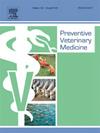Apparent prevalence and distribution of foot lesions in finishing French young bulls: A slaughterhouse cross-sectional study
IF 2.2
2区 农林科学
Q1 VETERINARY SCIENCES
引用次数: 0
Abstract
This study aimed to estimate the apparent prevalence of foot lesions and their distribution at the animal and batch levels in finishing French young bulls at slaughter, using a cross-sectional study conducted in four slaughterhouses. All 4 feet of 2102 young bulls (19.2 ± 2.4 months old) were collected and examined in spring and autumn 2023. Two methods were used to estimate lesion prevalence: a direct estimation based on all observed animals, and a logistic mixed-effects model accounting for clustering at the slaughterhouse and farm levels as random effects. The results presented here refer to the adjusted estimates, based on a subset of 1387 animals coming from 99 farms. Almost all animals were affected by at least one foot lesion. The most common included diffuse sole hemorrhages (SHD), affecting 83.1 % of animals and 99.4 % of batches, white line hemorrhages (WLH) affecting 49.5 % of animals and 97.1 % of batches, and heel horn erosion (HHE) present in 73.6 % of animals and 97.9 % of batches. Digital dermatitis (DD) affected 26.8 % of animals and approximately half the batches. Alarm lesions, potentially indicative of lameness, were observed in 30.8 % of young bulls. Among these, WLF and Bulb ulcer (BU) were more prevalent on hind feet, while other lesions showed no foot preference. Charolais young bulls showed a higher lesion prevalence than other breeds. This study provides valuable insights into foot health of finishing young bulls in France, highlighting frequent lesions in these indoor-reared animals and the presence of potentially lame individuals and widespread digital dermatitis.
法国育肥牛足部病变的明显患病率和分布:屠宰场横断面研究
本研究旨在通过在四个屠宰场进行的横断面研究,估计法国育肥牛屠宰时足部病变的明显患病率及其在动物和批次水平上的分布。本研究于2023年春秋两季采集了2102头(19.2 ± 2.4月龄)4尺公牛,并对其进行了检查。使用了两种方法来估计病变患病率:基于所有观察到的动物的直接估计,以及将屠宰场和农场水平的聚类作为随机效应考虑在内的logistic混合效应模型。这里给出的结果是基于来自99个农场的1387只动物的子集调整后的估计值。几乎所有的动物都至少有一种足部损伤。最常见的是弥漫性足底出血(SHD),影响83.1% %的动物和99.4% %的批次;白线出血(WLH)影响49.5% %的动物和97.1 %的批次;足后跟糜烂(HHE)影响73.6% %的动物和97.9% %的批次。数字性皮炎(DD)影响了26.8% %的动物和大约一半的批次。报警病变,潜在的跛行指示,在30.8 %的年轻公牛被观察到。其中,WLF和球茎溃疡(BU)多见于后足,而其他病变无足部偏好。夏来公牛的病变发生率高于其他品种。这项研究为法国育肥牛的足部健康提供了有价值的见解,突出了这些室内饲养动物的频繁病变,潜在跛行个体的存在和广泛的数字皮炎。
本文章由计算机程序翻译,如有差异,请以英文原文为准。
求助全文
约1分钟内获得全文
求助全文
来源期刊

Preventive veterinary medicine
农林科学-兽医学
CiteScore
5.60
自引率
7.70%
发文量
184
审稿时长
3 months
期刊介绍:
Preventive Veterinary Medicine is one of the leading international resources for scientific reports on animal health programs and preventive veterinary medicine. The journal follows the guidelines for standardizing and strengthening the reporting of biomedical research which are available from the CONSORT, MOOSE, PRISMA, REFLECT, STARD, and STROBE statements. The journal focuses on:
Epidemiology of health events relevant to domestic and wild animals;
Economic impacts of epidemic and endemic animal and zoonotic diseases;
Latest methods and approaches in veterinary epidemiology;
Disease and infection control or eradication measures;
The "One Health" concept and the relationships between veterinary medicine, human health, animal-production systems, and the environment;
Development of new techniques in surveillance systems and diagnosis;
Evaluation and control of diseases in animal populations.
 求助内容:
求助内容: 应助结果提醒方式:
应助结果提醒方式:


